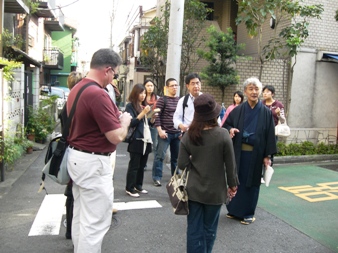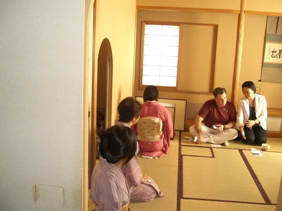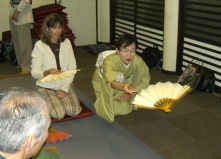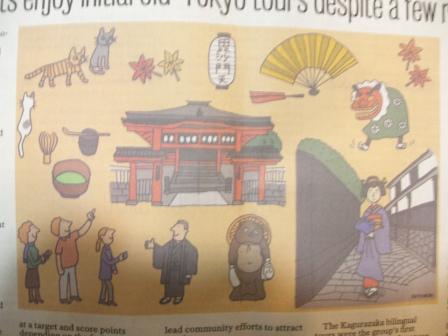"Kagurazaka Walk" in English (20/Oct. 2007)
|
|||||||||||||
| Two-hour Walking Tours in English. October 20,2007;¥3,000 each 9:30-11:30 followed by tea ceremony and sweets 2:00-4:00 including a fan-throwing game Explore stone-paved alleys and unusual shops with us in an area that remains a favorite haunt of kabuki actors, artists and musicians. See an exclusive ryotei restaurant where geisha still serve their customers with grace and charm. Learn about “IKI” the Japanese style or spirit that livens up cultural areas like this. |
 |
| Two-hour Walking Tours
in English. October 20,2007;¥3,000 each 9:30-11:30 followed by tea ceremony and sweets 2:00-4:00 including a fan-throwing game Explore stone-paved alleys and unusual shops with us in an area that remains a favorite haunt of kabuki actors, artists and musicians. See an exclusive ryotei restaurant where geisha still serve their customers with grace and charm. Learn about “IKI” the Japanese style or spirit that livens up cultural areas like this. |
 |
| >Following the morning tour we provide a tea ceremony and a chance for
you to enjoy traditional Japanese sweets with refreshing tea. After the afternoon tour you are invited to watch and participate in a Tosenkyo Fan Throwing Game . Between October 20th-November 4th,Kagurazaka celebrates its Kagurazaka Machitobi Festival with over 90 events including an art market and Japanese traditional entertainment like rakugo,koto music,Noh theater,etc. |
 |
Asahi.com>ENGLISH>LifeStyle> article Weekend Beat/LIFESTYLE & MORE: Participants enjoy initial old-Tokyo tours despite a few rough spots 11/03/2007 BY MOMOKO YOSHIDA, STAFF WRITER |
|
Jiro Sakamoto, a volunteer tour guide in Tokyo's Kagurazaka, led a group of eight people into a narrow cobblestone alley and gave them a brief history of the area in his signature husky voice. However, on a clear day on Oct. 20, a few things were new to Sakamoto. Unlike his usual street clothes, Sakamoto was wearing a dark blue kimono and zori. Also, after 10 years as a volunteer tour guide for Japanese visitors, this group was his first to include various nationalities, including an American and a French woman.Following Sakamoto, Rumi Yamaguchi, a government-licensed English tour guide, provided simultaneous interpretation. "The black fences, cobblestones and mikoshi-no-matsu pine trees are the three famous landmarks of the Kagurazaka alleys," she said in English.The tour was part of the kick-off events for the Kagurazaka Machitobi Festa 2007, the area's annual two-week festival held through Nov. 4. It features about 90 events, from modern arts to traditional Japanese performances, such as rakugo traditional storytelling and Noh performances.The first Machitobi Festa took place in 1999, organized by local businesses and associations, including the Kagurazaka Machizukuri-no-kai, a group dedicated to making the neighborhood more appealing to tourists. Sakamoto, 62, a member of the group, is the fourth-generation owner of a local glass store.This year, the Machizukuri-no-kai collaborated with the Institute for Japanese Cultural Exchange and Experience (IJCEE) to organize the experimental bilingual tours.About 50 people participated in the Oct. 20 tours, which visited the neighborhood in several groups, led by Machizukuri-no-kai volunteer guides and government-licensed English guides. Tourists included students from China, Korea and MalaysiaKagurazaka in Shinjuku Ward is an attractive destination for tourists because it retains the atmosphere of the Edo Period (1603-1867). Kagurazaka is also home to many France-related institutes including the L'Institut franco-japonais de Tokyo, French bistros and French expatriates.During the two-hour tour, Sakamoto pointed out famous ryotei (expensive traditional Japanese restaurants), an office that dispatches geisha, a long-established ryokan, temples and shrines.Though the translation was sometimes bumpy and the pace of the tour less than smooth, Sakamoto was agreeable and Yamaguchi vibrant. Laughter broke out frequently. Everybody appeared to have a good time, chatting after spontaneous introductions.The tours' biggest attractions were hands-on activities--the Japanese tea ceremony and tosenkyo, a traditional fan-tossing game.During the tea ceremony, participants drank powdered green tea following an age-old ritual and savored Japanese sweets.In tosenkyo, players toss a fan at a target and score points depending on the fan's relationship to the target.Chris Wuerthner, a member of the U.S. Air Force, works for the American Forces Network at Yokota Air Base in Fussa, Tokyo. He heard about the Kagurazaka tours on one of AFN's radio programs."It's easy to go to Roppongi, but I thought it would be nice to see the older part of Tokyo, too," Wuerthner said. "And I liked it very much."IJCEE was formed in May by graduates of Tokyo Planner Juku, a project launched in 2004 by the Tokyo metropolitan government to train people to lead community efforts to attract tourists. |
|
| Last year, the project developed special tourism courses at the Tokyo Metropolitan University. The university hopes to offer regular undergraduate and graduate tourism courses in the future.Ruriko Kigawa, a representative of IJCEE, said it is a volunteer organization made up of about 20 main members. All share an enthusiasm for providing non-Japanese with opportunities to get in touch with the "real" Japanese culture. Most of the members, including Kigawa, work for the group in their free time. |  |
Copyright(C) 2007-2009 Institute for Japanese Cultural Exchange and Experience All Rights Reserved